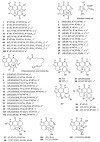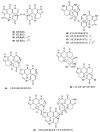Chemistry, Chemotaxonomy and Biological Activity of the Latrunculid Sponges (Order Poecilosclerida, Family Latrunculiidae)
- PMID: 33435402
- PMCID: PMC7827931
- DOI: 10.3390/md19010027
Chemistry, Chemotaxonomy and Biological Activity of the Latrunculid Sponges (Order Poecilosclerida, Family Latrunculiidae)
Abstract
Marine sponges are exceptionally prolific sources of natural products for the discovery and development of new drugs. Until now, sponges have contributed around 30% of all natural metabolites isolated from the marine environment. Family Latrunculiidae Topsent, 1922 (class Demospongiae Sollas, 1885, order Poecilosclerida Topsent, 1928) is a small sponge family comprising seven genera. Latrunculid sponges are recognized as the major reservoirs of diverse types of pyrroloiminoquinone-type alkaloids, with a myriad of biological activities, in particular, cytotoxicity, fuelling their exploration for anticancer drug discovery. Almost 100 pyrroloiminoquinone alkaloids and their structurally related compounds have been reported from the family Latrunculiidae. The systematics of latrunculid sponges has had a complex history, however it is now well understood. The pyrroloiminoquinone alkaloids have provided important chemotaxonomic characters for this sponge family. Latrunculid sponges have been reported to contain other types of metabolites, such as peptides (callipeltins), norditerpenes and norsesterpenes (trunculins) and macrolides (latrunculins), however, the sponges containing latrunculins and trunculins have been transferred to other sponge families. This review highlights a comprehensive literature survey spanning from the first chemical investigation of a New Zealand Latrunculia sp. in 1986 until August 2020, focusing on the chemical diversity and biological activities of secondary metabolites reported from the family Latrunculiidae. The biosynthetic (microbial) origin and the taxonomic significance of pyrroloiminoquinone related alkaloids are also discussed.
Keywords: Latrunculiidae; bioactivity; biosynthetic origin; callipeltin; chemotaxonomy; latrunculid sponge; pyrroloiminoquinone alkaloid; taxonomy.
Conflict of interest statement
The authors declare no conflict of interest.
Figures











Similar articles
-
Targeted Isolation of Tsitsikammamines from the Antarctic Deep-Sea Sponge Latrunculia biformis by Molecular Networking and Anticancer Activity.Mar Drugs. 2018 Aug 2;16(8):268. doi: 10.3390/md16080268. Mar Drugs. 2018. PMID: 30072656 Free PMC article.
-
Keeping it in the family: Coevolution of latrunculid sponges and their dominant bacterial symbionts.Microbiologyopen. 2017 Apr;6(2):e00417. doi: 10.1002/mbo3.417. Epub 2016 Oct 26. Microbiologyopen. 2017. PMID: 27781403 Free PMC article.
-
Chemical Diversity and Biological Activities of Marine Sponges of the Genus Suberea: A Systematic Review.Mar Drugs. 2019 Feb 12;17(2):115. doi: 10.3390/md17020115. Mar Drugs. 2019. PMID: 30759850 Free PMC article.
-
Molecular Networking Reveals Two Distinct Chemotypes in Pyrroloiminoquinone-Producing Tsitsikamma favus Sponges.Mar Drugs. 2019 Jan 16;17(1):60. doi: 10.3390/md17010060. Mar Drugs. 2019. PMID: 30654589 Free PMC article.
-
Chemistry and Biological Activities of the Marine Sponges of the Genera Mycale (Arenochalina), Biemna and Clathria.Mar Drugs. 2018 Jun 18;16(6):214. doi: 10.3390/md16060214. Mar Drugs. 2018. PMID: 29912171 Free PMC article. Review.
Cited by
-
A Soft Spot for Chemistry-Current Taxonomic and Evolutionary Implications of Sponge Secondary Metabolite Distribution.Mar Drugs. 2021 Aug 4;19(8):448. doi: 10.3390/md19080448. Mar Drugs. 2021. PMID: 34436287 Free PMC article. Review.
-
Expanded sampling of New Zealand glass sponges (Porifera: Hexactinellida) provides new insights into biodiversity, chemodiversity, and phylogeny of the class.PeerJ. 2023 Apr 27;11:e15017. doi: 10.7717/peerj.15017. eCollection 2023. PeerJ. 2023. PMID: 37131989 Free PMC article.
-
A Review of Sponge-Derived Diterpenes: 2009-2022.Mar Drugs. 2024 Sep 28;22(10):447. doi: 10.3390/md22100447. Mar Drugs. 2024. PMID: 39452855 Free PMC article. Review.
-
Miocene sponge assemblages in the face of the Messinian Salinity Crisis-new data from the Atlanto-Mediterranean seaway.PeerJ. 2023 Nov 16;11:e16277. doi: 10.7717/peerj.16277. eCollection 2023. PeerJ. 2023. PMID: 38025719 Free PMC article.
-
An Investigation of Structure-Activity Relationships and Cell Death Mechanisms of the Marine Alkaloids Discorhabdins in Merkel Cell Carcinoma Cells.Mar Drugs. 2023 Aug 29;21(9):474. doi: 10.3390/md21090474. Mar Drugs. 2023. PMID: 37755087 Free PMC article.
References
-
- Bergmann W., Feeney R.J. Contributions to the study of marine products. XXXII. The nucleosides of sponges. I. J. Org. Chem. 1951;16:981–987. doi: 10.1021/jo01146a023. - DOI
-
- Bergmann W., Burke D.C. Contributions to the study of marine products. XXXIX. The nucleosides of sponges. III. Spongothymidine and spongouridine. J. Org. Chem. 1955;20:1501–1507. doi: 10.1021/jo01128a007. - DOI
-
- De Laubenfels M.W. Sponges of the Western Bahamas. American Museum Novitates. American Museum of Natural History; New York, NY, USA: 1949.
Publication types
MeSH terms
Substances
LinkOut - more resources
Full Text Sources
Other Literature Sources

